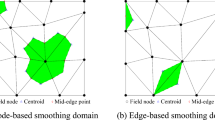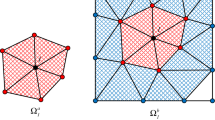Abstract
In this work, a stable node-based smoothed finite element method (SNS-FEM) is presented for curing temporal instability of NS-FEM in 3D contact problems. In present method, each node-based domain generated by NS-FEM is firstly equivalent to spherical region with the same volume. Then six temporary integral points are symmetrically distributed at the intersection of the equivalent spherical and the global Cartesian coordinate system to construct the stable terms related to the gradient of the smoothed shape function derivatives. It turns out the stable terms help the SNS-FEM obtain items of the ideal stiffness matrix and internal force vector. Meanwhile, by means of the basic boundary value equation of Coulomb friction contact, the SNS-FEM successfully maintains the stability of the load transfer between the master/slave surfaces and relaxes the sensitivity of the mesh deformation. Its effectiveness and potentialities can be well represented and clarified by several numerical examples containing benchmark case.






















Similar content being viewed by others
References
Wriggers P (2006) Computational contact mechanics, 2nd edn. Wiley & Sons, Hoboken
Johnson KL (1985) Contact mechanics. Camb Univ Press 4:659
Hild P, Renard Y (2010) A stabilized Lagrange multiplier method for the finite element approximation of contact problems in elastostatics. Numer Math 115:101–129. https://doi.org/10.1007/s00211-009-0273-z
Papadopoulos P, Solberg JM (1998) A Lagrange multiplier method for the finite element solution of frictionless contact problems. Math Comput Model 28:373–384. https://doi.org/10.1016/S0895-7177(98)00128-9
Weyler R, Oliver J, Sain T, Cante JC (2012) On the contact domain method: a comparison of penalty and Lagrange multiplier implementations. Comput Methods Appl Mech Eng 205–208:68–82. https://doi.org/10.1016/j.cma.2011.01.011
Mijar AR, Arora JS (2004) An augmented lagrangian optimization method for contact analysis problems, 2: numerical evaluation. Struct Multidiscip Optim 28:113–126. https://doi.org/10.1007/s00158-004-0424-x
Heegaard J-H, Curnier A (1993) An augmented Lagrangian method for discrete large-slip contact problems. Int J Numer Methods Eng 36:569–593. https://doi.org/10.1002/nme.1620360403
Simo JC, Laursen TA (1992) An augmented lagrangian treatment of contact problems involving friction. Comput Struct 42:97–116. https://doi.org/10.1016/0045-7949(92)90540-G
McDevitt TW, Laursen TA (2000) A mortar-finite element formulation for frictional contact problems. Int J Numer Methods Eng 48:1525–1547. https://doi.org/10.1002/1097-0207(20000810)48:10%3c1525::AID-NME953%3e3.0.CO;2-Y
Duong TX, De Lorenzis L, Sauer RA (2019) A segmentation-free isogeometric extended mortar contact method. Comput Mech 63:383–407. https://doi.org/10.1007/s00466-018-1599-0
Anitescu M, Potra FA (1997) Formulating dynamic multi-rigid-body contact problems with friction as solvable linear complementarity problems. Nonlinear Dyn 14:231–247. https://doi.org/10.1023/A:1008292328909
Meingast MB, Legrand M, Pierre C (2014) A linear complementarity problem formulation for periodic solutions to unilateral contact problems. Int J Non Linear Mech 66:18–27. https://doi.org/10.1016/j.ijnonlinmec.2014.01.007
Yang B, Laursen TA (2008) A large deformation mortar formulation of self contact with finite sliding. Comput Methods Appl Mech Eng 197:756–772. https://doi.org/10.1016/j.cma.2007.09.004
Puso MA, Laursen TA (2004) A mortar segment-to-segment contact method for large deformation solid mechanics. Comput Methods Appl Mech Eng 193:601–629. https://doi.org/10.1016/j.cma.2003.10.010
Laursen TA, Puso MA, Sanders J (2012) Mortar contact formulations for deformable–deformable contact: past contributions and new extensions for enriched and embedded interface formulations. Comput Methods Appl Mech Eng 205–208:3–15. https://doi.org/10.1016/j.cma.2010.09.006
Farah P, Popp A, Wall WA (2015) Segment-based vs. element-based integration for mortar methods in computational contact mechanics. Comput Mech 55:209–228. https://doi.org/10.1007/s00466-014-1093-2
Andersson T (1981) The boundary element method applied to two-dimensional contact problems with friction BT—boundary element methods. In: Brebbia CA (ed). Springer, Berlin, pp 239–258
Maier G, Novati G, Cen Z (1993) Symmetric Galerkin boundary element method for quasi-brittle-fracture and frictional contact problems. Comput Mech 13:74–89. https://doi.org/10.1007/BF00350704
Eck C, Steinbach O, Wendland WL (1999) A symmetric boundary element method for contact problems with friction. Math Comput Simul 50:43–61. https://doi.org/10.1016/s0378-4754(99)00060-9
Li Y, Liu GR, Dai KY et al (2007) Contact analysis for solids based on linearly conforming radial point interpolation method. Comput Mech 39:537–554. https://doi.org/10.1007/s00466-006-0057-6
Rabczuk T, Belytschko T (2007) A three-dimensional large deformation meshfree method for arbitrary evolving cracks. Comput Methods Appl Mech Eng 196:2777–2799. https://doi.org/10.1016/j.cma.2006.06.020
Wriggers P, Scherf O (1995) An adaptive finite element algorithm for contact problems in plasticity. Comput Mech 17:88–97
Bostan V, Han W (2006) A posteriori error analysis for finite element solutions of a frictional contact problem. Comput Methods Appl Mech Eng 195:1252–1274
Damm NB, Morlock MM, Bishop NE (2015) Friction coefficient and effective interference at the implant-bone interface. J Biomech 48:3517–3521
Liu GR (2012) AG space theory and a weakened weak (W2) form for a unified formulation of compatible and incompatible methods: Part I theory. Int J Numer Methods Eng 1096–1126
Yue JH, Li M, Liu GR, Niu RP (2016) Proofs of the stability and convergence of a weakened weak method using PIM shape functions. Comput Math with Appl 72:933–951. https://doi.org/10.1016/j.camwa.2016.06.002
Liu GR (2012) AG space theory and a weakened weak (W2) form for a unified formulation of compatible and incompatible methods: part II applications to solid mechanics problems G. Int J Numer Methods Eng 81:1127–1156. https://doi.org/10.1002/nme.2720
Zeng W, Liu GR (2018) Smoothed finite element methods (S-FEM): an overview and recent developments. Arch Comput Methods Eng 25:397–435
Feng H, Cui X, Li G (2012) Static and dynamic analysis of timoshenko beam using nodal integration technique. Int J Appl Mech 4:1–20. https://doi.org/10.1142/S1758825112500457
Liu GR, Nguyen-Thoi T, Nguyen-Xuan H, Lam KY (2009) A node-based smoothed finite element method (NS-FEM) for upper bound solutions to solid mechanics problems. Comput Struct 87:14–26. https://doi.org/10.1016/j.compstruc.2008.09.003
Ziervogel G, Cartwright A, Tas A et al (2008) Climate change and adaptation in African agriculture. Training 4179:53. https://doi.org/10.1002/cnm
Cui XY, Liu GR, Li GY et al (2008) A smoothed finite element method (SFEM) for linear and geometrically nonlinear analysis of plates and shells. C Comput Model Eng Sci 28:109–125. https://doi.org/10.3970/cmes.2008.028.109
Remacle J, Lambrechts J, Seny B (2012) Blossom-Quad: a non-uniform quadrilateral mesh generator using a minimum-cost perfect-matching algorithm. International. https://doi.org/10.1002/nme
Cui XY, Liu GR, Li GY et al (2010) Analysis of plates and shells using an edge-based smoothed finite element method. Comput Mech 45:141–156. https://doi.org/10.1007/s00466-009-0429-9
Liu GR, Nguyen-Thoi T, Lam KY (2009) An edge-based smoothed finite element method (ES-FEM) for static, free and forced vibration analyses of solids. J Sound Vib 320:1100–1130. https://doi.org/10.1016/j.jsv.2008.08.027
Ren S, Na C, Meng G et al (2020) Stabilized node-based smoothed radial point interpolation method for micromechanical analysis of the magneto-electro-elastic structures in thermal environment. Math Methods Appl Sci. https://doi.org/10.1002/mma.6832
Tang Q, Zhang GY, Liu GR et al (2011) A three-dimensional adaptive analysis using the meshfree node-based smoothed point interpolation method (NS-PIM). Eng Anal Bound Elem 35:1123–1135. https://doi.org/10.1016/j.enganabound.2010.05.019
Wu SC, Liu GR, Zhang HO et al (2009) A node-based smoothed point interpolation method (NS-PIM) for three-dimensional heat transfer problems. Int J Therm Sci 48:1367–1376. https://doi.org/10.1016/j.ijthermalsci.2008.10.010
Liu GR, Chen L, Nguyen-Thoi T et al (2010) A novel singular node-based smoothed finite element method (NS-FEM) for upper bound solutions of fracture problems. Int J Numer Methods Eng 83:1466–1497. https://doi.org/10.1002/nme
Li Y, Liu GR, Zhang GY (2011) An adaptive NS/ES-FEM approach for 2D contact problems using triangular elements. Finite Elem Anal Des 47:256–275. https://doi.org/10.1016/j.finel.2010.10.007
Zhang Z-Q, Liu GR (2010) Temporal stabilization of the node-based smoothed finite element method and solution bound of linear elastostatics and vibration problems. Comput Mech 46:229–246. https://doi.org/10.1007/s00466-009-0420-5
Liu GR, Nguyen-Thoi T, Lam KY (2008) A novel alpha finite element method (αFEM) for exact solution to mechanics problems using triangular and tetrahedral elements. Comput Methods Appl Mech Eng 197:3883–3897. https://doi.org/10.1016/j.cma.2008.03.011
Nguyen-Xuan H, Rabczuk T, Nguyen-Thanh N et al (2010) A node-based smoothed finite element method with stabilized discrete shear gap technique for analysis of Reissner-Mindlin plates. Comput Mech 46:679–701. https://doi.org/10.1007/s00466-010-0509-x
Li S, Cui X, Feng H, Wang G (2017) An electromagnetic forming analysis modelling using nodal integration axisymmetric thin shell. J Mater Process Technol 244:62–72. https://doi.org/10.1016/j.jmatprotec.2017.01.028
Cui X, Li S, Feng H, Li G (2017) A triangular prism solid and shell interactive mapping element for electromagnetic sheet metal forming process. J Comput Phys 336:192–211. https://doi.org/10.1016/j.jcp.2017.02.014
Li S, Cui X, Li G (2018) Modelling and demonstration of electromagnetically assisted stamping system using an interactive mapping method. Int J Mech Sci 144:312–323. https://doi.org/10.1016/j.ijmecsci.2018.06.003
Feng H, Cui XY, Li GY (2016) A stable nodal integration method with strain gradient for static and dynamic analysis of solid mechanics. Eng Anal Bound Elem 62:78–92. https://doi.org/10.1016/j.enganabound.2015.10.001
Yang H, Cui XY, Li S, Bie YH (2019) A stable node-based smoothed finite element method for metal forming analysis. Comput Mech 63:1147–1164. https://doi.org/10.1007/s00466-018-1641-2
Dias APC, Proenca SPB, Bittencourt ML (2019) High-order mortar-based contact element using NURBS for the mapping of contact curved surfaces. Comput Mech 64:85–112. https://doi.org/10.1007/s00466-018-1658-6
Zimmerman BK, Ateshian GA (2018) A surface-to-surface finite element algorithm for large deformation frictional contact in febio. J Biomech Eng 140:1–15
Bertsekas DP, Rheinboldt W (1982) Constrained optimization and lagrange multiplier methods. Elsevier Inc, Acad Press, Amsterdam
Liu P, Cui X, Wang G et al (2018) An accurate and efficient scheme for linear and nonlinear analyses based on a gradient-weighted technique. Int J Non Linear Mech 105:9–19. https://doi.org/10.1016/j.ijnonlinmec.2018.07.011
Usman M, Hamid M, Khalid MSU et al (2020) A robust scheme based on novel-operational matrices for some classes of time-fractional nonlinear problems arising in mechanics and mathematical physics. Numer Methods Partial Differ Equ 36:1566–1600. https://doi.org/10.1002/num.22492
Bathe K-J, Ramm E, Wilson EL (1975) Finite element formulations for large deformation dynamic analysis. Int J Numer Methods Eng 9:353–386. https://doi.org/10.1002/nme.1620090207
Beissel S, Belytschko T (1996) Nodal integration of the element-free Galerkin method. Comput Methods Appl Mech Eng 139:49–74
Hild P (2000) Numerical implementation of two nonconforming finite element methods for unilateral contact. Comput Methods Appl Mech Eng 184:99–123. https://doi.org/10.1016/S0045-7825(99)00096-1
Temizer I (2012) A mixed formulation of mortar-based frictionless contact. Comput Methods Appl Mech Eng 223–224:173–185. https://doi.org/10.1016/j.cma.2012.02.017
Agrawal V, Gautam SS (2020) Varying-order NURBS discretization: an accurate and efficient method for isogeometric analysis of large deformation contact problems. Comput Methods Appl Mech Eng 367:113125. https://doi.org/10.1016/j.cma.2020.113125
Areias P, Rabczuk T, de Melo FJMQ, de Sá JC (2015) Coulomb frictional contact by explicit projection in the cone for finite displacement quasi-static problems. Comput Mech 55:57–72. https://doi.org/10.1007/s00466-014-1082-5
Acknowledgements
The support of National Science Foundation of China (11872177), National Science Foundation of China (12002124), Changsha Municipal Natural Science Foundation (43386), and State Key Laboratory of Advanced Design and Manufacturing for Vehicle Body (32065007) are gratefully acknowledged.
Author information
Authors and Affiliations
Corresponding author
Additional information
Publisher's Note
Springer Nature remains neutral with regard to jurisdictional claims in published maps and institutional affiliations.
Rights and permissions
About this article
Cite this article
Sun, X., Yang, H., Li, S. et al. Stable node-based smoothed finite element method for 3D contact problems. Comput Mech 69, 787–804 (2022). https://doi.org/10.1007/s00466-021-02114-1
Received:
Accepted:
Published:
Issue Date:
DOI: https://doi.org/10.1007/s00466-021-02114-1




